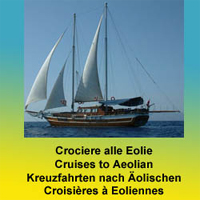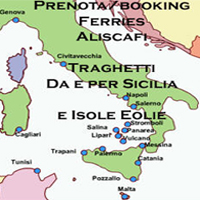The colors of the Aeolian Islands
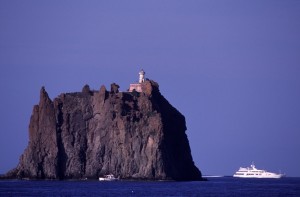
In the north-east of Sicily there is a corner of paradise where the mystery of nature is reflected seven times in the waters of a crystal clean sea.
One has the impression to admire something that belongs at the beginning of the world, the seven islands of the archipelago emerge from the sea like seven huge chunks of volcanic land and anchored to the depths of the sea.
The islands have been praised and immortalized by writers and painters and great travelers of the past such as Dumas, Archduke Louis Salvador of Austria (Louis Salvator of Habsburg-Lorraine branch of Tuscany), Deodat de Dolomieu, Spallanzani, and still others have described in tones imaginative and evocative.
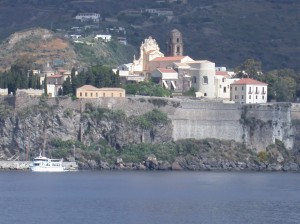
The formation of the seven islands started more than 700,000 years ago, and it helped the lifting of the marine Quaternary age, even today, the Aeolian Islands are for the students a real open book, a natural workshop where the evolution of Our planet can be studied at first.
The primal fire, the ancient clash between the elements have created a diverse set of extraordinary coastline were generated caves, cliffs, obelisks, rocks, smooth walls, black beaches surrounded by a sea full of fish to this day.
The volcanic soil is fertile and all the islands were once covered with forests of oak and oak and a Mediterranean impenetrable man, especially in the last two centuries, has largely replaced with agricultural crops.
![]()
Communication difficulties of the past between islands and mainland imposed, in fact, a total food self-sufficiency, which has led to the division of the arable land in the fields, often made of dry stone walls and terraces built entirely by hand by generations of farmers.
Today, the agricultural land has more the appearance of a time and olive trees, almond, fig and caper lives that had taken the place of the spot are greatly reduced as production companies. However, it was felt in recent times a significant recovery in agriculture on the initiative of private citizens who have returned to cultivate abandoned vineyards and producing wine, while others produce homemade pickles and pickled products.
The lava that created the seven islands was also indispensable for the building of the oldest Aeolian houses that still characterize the landscape, they are very basic cubes side by side horizontally or vertically, depending on the needs of individual families.

Openings for access and light were small and very thick walls to keep the heat in the winter in the kitchen or on simple braziers and to get cool in summer. The bases were in mint blocks of lava, pumice stone walls, and floors of the terraces tuff.
Every part of the building was strictly related to the housing economy, so, for example, the so-called “astrico” or the roof terrace, was used to collect rainwater in underground tanks below egg-shaped.
The entrance to the house opened on to “bagghiu”, a covered terrace with a vine or cane roof supported by large cylindrical stone pillars with plaster “pulera.”
Along the “bagghiu” there was always a long stone floor seating, which opened at the mouth of the cistern and, nearby, was placed the wash.
Even today in the Aeolian Islands offer perfect natural environments, where you can feel the serenity, tourists are attracted, as once the writers and artists who made known to the world, with extraordinary natural scenery and numerous traces of the past.
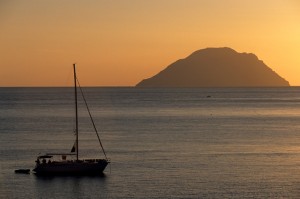
It is possible to visit the remains of ancient villages of the primitive hut, climb the sides of active volcanoes to observe closely the explosions, along paths in the bush that can reach the corners of wild beauty where you can still see hawks, buzzards and ravens, visit ancient ruins and museum collections in the world.
The coasts offer boat trips and unexpected glimpses of caves, crags, cliffs, beaches of fine volcanic sand.
Each island of the archipelago is specializing more and more of its tourist offer, Lipari, the largest, attracts numerous Italian and foreign visitors for the great natural and cultural heritage and which offers, usually on day trips to the other islands.
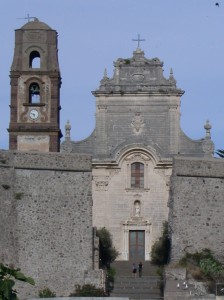
Salina is devoted instead to attract families and couples, who owned homes and rental and small romantic hotels.
Vulcano attracts a young tourists.Panarea, the island chosen by Italian and foreign celebrities who have restored houses, is vital and burning of color and light, with its shops, hotels and trendy nightclubs.
Filicudi, more quiet, is for tourists who wish to get away from the crowds, but that does not enjoy traveling around by car or by boat, the evening meeting up with their friends every summer.
Alicudi is a very special place, only suitable for purists; over the island there are no roads or paths, just an endless succession of stone steps leading up the side of the volcano and connecting scattered clusters of authentic Aeolian houses very well restored. The island has a small restaurant and two grocery stores well stocked.
Finally, Stromboli, inhabited by people from Sicily and other parts of the world, who have decided to live here in close contact with nature.




